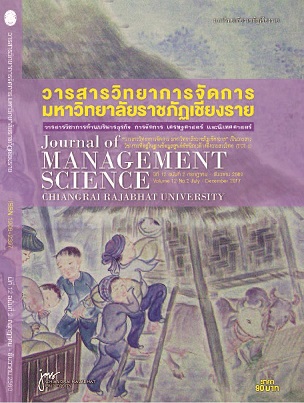Identities Analysis for the Value Added of Cultural Tourism Destinations in Chiang Rai Special Economic Zone
Main Article Content
Abstract
The aims of this study were: 1) to survey identities of cultural tourism destinations in Chiang Rai Special Economic Zone; 2) to analyze identity-oriented attributes for the value added of cultural tourism destinations in Chiang Rai Special Economic Zone; and 3) to develop marketing approach for the identities of cultural tourism destinations in Chiang Rai Special Economic Zone.
This qualitative study employed an in-depth interview with 10 scholars, and employed quantitative method by using 400 questionnaires to collect the data regarding people’s opinion toward promoting the sites in Chiang Rai Special Economic Zone for cultural tourism destinations. The study nevertheless recruited 3 experts to analysis form to analyze the potential of cultural tourism destinations in Chiang Rai Special Economic Zone.
The findings showed that: the shared identities of cultural tourism destinations in Chiang Rai Special Economic Zone that they were border towns that held long history of city establishment so they housed archeological sites and artefacts. The people’s opinion revealed that they wanted to see their local area becoming cultural tourism destinations at the high level, especially, in regard to festival/tradition/activities, people in Maesai, Chiang Saen, and Chiang Khong wanted to promote their homes to become cultural tourism destinations at the highest level.For detailed analysis, it was found that Maesai’s distinct identity was border trading city, and Chiang Saen was an ancient town, while Chiang Khong held the hybrid 2 in 1 combination.
The guidelines for marketing communication on identities of cultural tourism destinations in Chiang Rai Special Economic Zone were the following that: 1) the use of advertising and public relations media to promote tourism based on each group of tourists, 2) the use of community brand for marketing communication, 3) the use of historical development of the city to create storytelling, 4) the use of theme for marketing communication to maintain unity and consistent direction of advertising and public relations activities from community to provincial level, 5) the use of new tourism activities to attract the tourists, and 6) the use of integrated communication tools is needed for effective communication of the above-mentioned content.
Article Details
Views and opinions expressed in the journal do not necessarily reflect those of the editors.
References
เกศกนก ชุ่มประดิษฐ์ และจิราพร ขุนศรี. (2549). อัตลักษณ์และภาพลักษณ์ของจังหวัดเชียงราย.รายงานวิจัยฉบับสมบูรณ์. สำนักงานกองทุนสนับสนุนการวิจัย.
ฉลาดชาย รมิตานนท์.(2550). การเมืองเรื่องอัตลักษณ์ (Identity Politics). https://www.soc.cmu.ac.th/%7Ewsc/data/Identity20politics.pdf. (สืบค้นเมื่อ 29/08/2558).
เชียงราย ‘เขตเศรษฐกิจพิเศษ’ อย่างไร https://chiangrainews.org/ (สืบค้นเมื่อ 29/07/2558).
ธิติพัฒน์ เอี่ยมนิรันดร์. 2554.เอกสารการสอนชุดวิชาการสื่อสารการตลาด. หน่วยที่ 1-7.นนทบุรี: สำนักพิมพ์มหาวิทยาลัยสุโขทัยธรรมาธิราช.
นธกฤต วันต๊ะเมล์. (2555). การสื่อสารการตลาด. กรุงเทพมหานคร:สำนักพิมพ์มหาวิทยาลัยเกษตรศาสตร์.
ปรีชา ศรีศักดิ์หิรัญ.2554.เอกสารการสอนชุดวิชาการสื่อสารและการส่งเสริมการตลาด หน่วยที่ 1-7.นนทบุรี: สำนักพิมพ์มหาวิทยาลัยสุโขทัยธรรมาธิราช.
สุรพงษ์ โสธนะเสถียร. (2556). ทฤษฎีการสื่อสาร. กรุงเทพมหานคร: โรงพิมพ์ระเบียงทอง.
เสริมศิริ นิลดำและคณะ.(2560).การพัฒนาเส้นทางการท่องเที่ยวตามรอยชาติพันธุ์ในจังหวัดเชียงราย.วารสารวิจัยราชภัฏพระนคร สาขามนุษยศาสตร์และสังคมศาสตร์ ปีที่12 ฉบับที่ 1(มกราคม-มิถุนายน 2560).
ศิริวรรณ เสรีรัตน์และคณะ.2535.การโฆษณาและการส่งเสริมการตลาด.กรุงเทพมหานคร: บริษัท A.N. การพิมพ์.
อภิญญา เฟื่องฟูสกุล.(2546). อัตลักษณ์ Identity การทบทวนทฤษฎีและกรอบแนวคิด. กรุงเทพฯ: คณะกรรมการสภาวิจัยแห่งชาติ สาขาสังคมวิทยา สำนักงานคณะกรรมการวิจัยแห่งชาติ.
Baltescu ,C.A. and Boscor, D. (2013). An Analysis of The Cultural Tourism Development in Romania. Bullentin of the Transilvania University of Brasov, Vol.6(55), No.2, pp.116-120.
Baristic, P. and others. (2012).The Image and Identity of Croatia as A Tourist Destination:An Exploratory Study. Enterprise Odyssey. International Conference Proceedings.Online Available at https://search.proquest.com/docview/13 50307774?accountid=32082 [เข้าถึงเมื่อ 20/07/2015]
Baristic, P. and Blazevic, Z. (2014). Visual Identity Components of Tourist Destination.International Journal of Social, Behavioral, Educational, Economic and Management Engineering Vol.8, No.7, Pp.2170-2174.
Carmen, I.M. and Ciochina, I. (2014). Tourism Brand – The Premise of A Positive Image for A Tourist Destination. Study Case: ROMANIA. International Journal of Information,Business and Management. Online Available at https://search.proquest.com/docview/1530089149?accountid=32082 [สืบค้นเมื่อ 20/07/2015]
Delozier.M. (1976). The Marketing Communication Process.London : McGraw Hill. McGrawHill.
ICOMOS. (1999). Cultural Tourism Charter: Principle and Guidelines for Managing Tourism at Places of Cultural and Heritage Significance. Australia: ICOMOS.
Konecnik, M. and Go, F. (2008). Tourism Destination Brand Identity: The Case of Slovenia. Brand Management. Vol.15, No.3 January 2008., pp.177-189.
Kotler.P.(2003).Marketing management. Upper Saddle River, NJ: Prentice- Hall.
Kotler, Philip, Jain ,Dipak C. and Maesincee, Suvit.(2002).Marketing moves: A new approach to profits, growth, and renewal. Boston. Massachusetts: Harvard Business School Press.
Lin, Yi-Chin and others. (2009). Food as a form of destination identity: A tourism destination brand perspective. Tourism and Hospitality Research vol.11, 1, 30-48.
Rudan, Elena. (2010). The Development of Cultural Tourism in Small Historical Towns. Tourism & Hospitality Management 2010, Conference Proceedings, pp.557-586.
Urosevic, N. (2010). Development and Market Potential of Cultural Tourism – Istrian Case Study. International Conference ICES2010. Economic Development Perspectives of SEE Region in Global Recession Context. October 14-15, 2010, Sarajevo. Online Available at https://search.proquest.com/docview/1017708949?accountid=32082 [สืบค้นเมื่อ 20/07/2015]
Zadel, Z. and Bogdan, S. (2013). Economic Impact of Cultural Tourism. UTMS Journal of Economics 4(3), pp.355-266.


